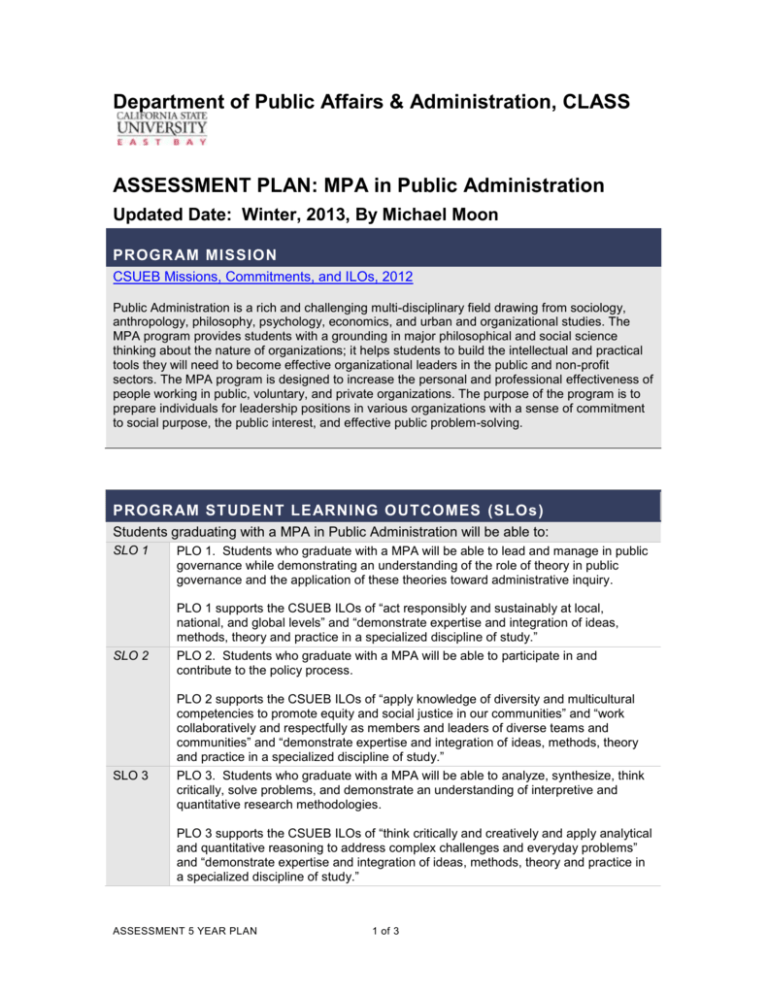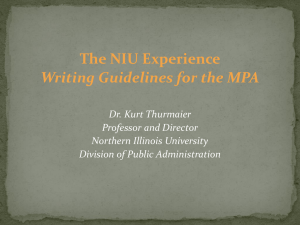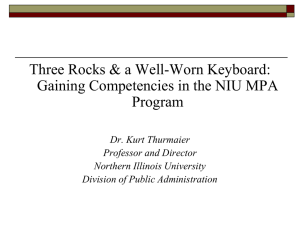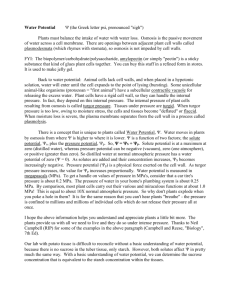ASSESSMENT PLAN: MPA in Public Administration
advertisement

Department of Public Affairs & Administration, CLASS ASSESSMENT PLAN: MPA in Public Administration Updated Date: Winter, 2013, By Michael Moon PROGRAM MISSION CSUEB Missions, Commitments, and ILOs, 2012 Public Administration is a rich and challenging multi-disciplinary field drawing from sociology, anthropology, philosophy, psychology, economics, and urban and organizational studies. The MPA program provides students with a grounding in major philosophical and social science thinking about the nature of organizations; it helps students to build the intellectual and practical tools they will need to become effective organizational leaders in the public and non-profit sectors. The MPA program is designed to increase the personal and professional effectiveness of people working in public, voluntary, and private organizations. The purpose of the program is to prepare individuals for leadership positions in various organizations with a sense of commitment to social purpose, the public interest, and effective public problem-solving. PROGRAM STUDENT LE ARNING OUTCOMES (SLOs) Students graduating with a MPA in Public Administration will be able to: SLO 1 SLO 2 SLO 3 PLO 1. Students who graduate with a MPA will be able to lead and manage in public governance while demonstrating an understanding of the role of theory in public governance and the application of these theories toward administrative inquiry. PLO 1 supports the CSUEB ILOs of “act responsibly and sustainably at local, national, and global levels” and “demonstrate expertise and integration of ideas, methods, theory and practice in a specialized discipline of study.” PLO 2. Students who graduate with a MPA will be able to participate in and contribute to the policy process. PLO 2 supports the CSUEB ILOs of “apply knowledge of diversity and multicultural competencies to promote equity and social justice in our communities” and “work collaboratively and respectfully as members and leaders of diverse teams and communities” and “demonstrate expertise and integration of ideas, methods, theory and practice in a specialized discipline of study.” PLO 3. Students who graduate with a MPA will be able to analyze, synthesize, think critically, solve problems, and demonstrate an understanding of interpretive and quantitative research methodologies. PLO 3 supports the CSUEB ILOs of “think critically and creatively and apply analytical and quantitative reasoning to address complex challenges and everyday problems” and “demonstrate expertise and integration of ideas, methods, theory and practice in a specialized discipline of study.” ASSESSMENT 5 YEAR PLAN 1 of 3 SLO 4 PLO 4. Students who graduate with a MPA will be able to articulate and apply a public service perspective. PLO 4 supports the CSUEB ILOs of “communicate ideas, perspectives, and values clearly and persuasively while listening openly to others” and “act responsibly and sustainably at local, national, and global levels.” SLO 5 PLO5. Students who graduate with a MPA will be able to communicate and interact productively with a diverse and changing workforce and citizenry. PLO 5 supports the CSUEB ILOs of “communicate ideas, perspectives, and values clearly and persuasively while listening openly to others” and “work collaboratively and respectfully as members and leaders of diverse teams and communities.” Year 1: 2012-2013 1. Which SLO(s) to assess 1-5 2. Assessment indicators MPA Exit Survey, a 21-item survey that indirectly measures our graduates’ perception of success with the MPA PLOs. PUAD 6901 (Graduate Synthesis) is the MPA capstone course and requires the completion of an essay exam, which is designed to directly assess the students’ level of competency. 3. Sample (courses/# of students) 4. Time (which quarter(s)) PUAD 6901 (Graduate Synthesis) is the MPA capstone course and requires the completion of an essay exam, which is designed to directly assess the students’ level of competency. Spring 5. Responsible person(s) n/a 6. Ways of reporting (how, to who) Annual reports 7. Ways of closing the loop Faculty meeting Year 2: 2013-2014 1. Which SLO(s) to assess 1-5 2. Assessment indicators MPA Exit Survey, a 21-item survey that indirectly measures our graduates’ perception of success with the MPA PLOs. PUAD 6901 (Graduate Synthesis) is the MPA capstone course and requires the completion of an essay exam, which is designed to directly assess the students’ level of competency. 3. Sample (courses/# of students) 4. Time (which quarter(s)) PUAD 6901 (Graduate Synthesis) is the MPA capstone course and requires the completion of an essay exam, which is designed to directly assess the students’ level of competency. 25 students assessed. Winter 5. Responsible person(s) n/a 6. Ways of reporting (how, to who) Annual reports, Advisory Board 7. Ways of closing the loop Faculty meeting Year 3: 2014-2015 1. Which SLO(s) to assess 1-5 2. Assessment indicators MPA Exit Survey, a 21-item survey that indirectly measures our graduates’ perception of success with the MPA PLOs. PUAD ASSESSMENT 5 YEAR PLAN 2 of 3 6901 (Graduate Synthesis) is the MPA capstone course and requires the completion of an essay exam, which is designed to directly assess the students’ level of competency. 3. Sample (courses/# of students) 4. Time (which quarter(s)) PUAD 6901 (Graduate Synthesis) is the MPA capstone course and requires the completion of an essay exam, which is designed to directly assess the students’ level of competency. 25 students assessed. TBD 5. Responsible person(s) n/a 6. Ways of reporting (how, to who) Annual reports, Advisory Board 7. Ways of closing the loop Faculty meeting Year 4: 2015-2016 1. Which SLO(s) to assess 1-5 2. Assessment indicators MPA Exit Survey, a 21-item survey that indirectly measures our graduates’ perception of success with the MPA PLOs. PUAD 6901 (Graduate Synthesis) is the MPA capstone course and requires the completion of an essay exam, which is designed to directly assess the students’ level of competency. 3. Sample (courses/# of students) 4. Time (which quarter(s)) PUAD 6901 (Graduate Synthesis) is the MPA capstone course and requires the completion of an essay exam, which is designed to directly assess the students’ level of competency. 25 students assessed. TBD 5. Responsible person(s) n/a 6. Ways of reporting (how, to who) Annual reports, Advisory Board 7. Ways of closing the loop Faculty meeting Year 5: 2016-2017 1. Which SLO(s) to assess 1-5 2. Assessment indicators MPA Exit Survey, a 21-item survey that indirectly measures our graduates’ perception of success with the MPA PLOs. PUAD 6901 (Graduate Synthesis) is the MPA capstone course and requires the completion of an essay exam, which is designed to directly assess the students’ level of competency. 3. Sample (courses/# of students) 4. Time (which quarter(s)) PUAD 6901 (Graduate Synthesis) is the MPA capstone course and requires the completion of an essay exam, which is designed to directly assess the students’ level of competency. 25 students assessed. TBD 5. Responsible person(s) n/a 6. Ways of reporting (how, to who) Annual reports, Advisory Board 7. Ways of closing the loop Faculty meeting ASSESSMENT 5 YEAR PLAN 3 of 3









